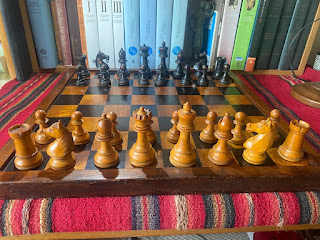Dragons and Chickens and Chess Oh My!-The Bohemia German Chess Series
For collectors, the excitement of acquiring a new item comes not only from possession but also from the research and learning that comes with it. Recently, I had the pleasure of acquiring an original German chess set dating back to the 1950s-1960s, which came with a stunning box and board. The set was produced by a company called Bohemia, and in this blog post, I invite you to join me on my journey of discovery as I explore the exquisite chess set and its origins. Furthermore, I will delve into some intriguing chess games that were played on similar Bohemia sets during the 19th Chess Olympiad in Siegen, Germany.
Researching the history of the Bohemia chess factory was difficult because there isn't much information online (I hope this Blog post adds to the available information). However, I was lucky enough to get in touch with Holger Langer, an expert chess collector from Hamburg, Germany, who had communicated directly with the former owner. He provided me with valuable insights about the company's beginnings. Holger explained the factory was established in Querfurt, Saxony Anhalt in 1946, immediately after World War II. It later moved to Heiligkreuzsteinach in the Odenwald region near Heidelberg in 1952.
Heiligkreuzsteinach, Germany (Wikipedia) |
Unfortunately, in 2019, the company came to an end when its former owner and managing director, an elderly woman named Edda Dittler, was unable to find anyone to take over the business after she retired (anyone interested?).
One of the most highly prized sets created by the Bohemia chess manufacturer was the "Dragon Knight"collection, which was meticulously handcrafted from a combination of maple and walnut and had a moderate weight that made it particularly desirable to collectors. These sets were predominantly produced around the 1960s, and while older sets had finials with opposite colors on the Bishops, newer sets had uniform finials. The set that included the "chicken" knight was likely produced between the late 1960s and 1970 and was used in the 1970 Chess Olympiad in Siegen, Germany. The names "Dragon" and "Chicken" Knight describe the features of two distinct series produced by Bohemia. It is important to note that these sets are not derived from the "Bohemian region" (Czech.), but rather from the actual name of the company, "Bohemia." Therefore, these names are frequently confused by people (including myself at first).
The "Dragon" set Up Close
Examining my recently acquired chess set, the Bohemia "Dragon" Knight is an intricately carved piece with a fiery-looking mane, a sturdy head, and a slender neck. Its pointed ears and open mouth add to its striking appearance. Although some have compared it to a dog, I have seen other knight pieces that resemble canines more closely, so I prefer to refer to it as a "Dragon" Knight. Interestingly, it reminds me of the character "Falkor" from the 1984 film, The NeverEnding Story.
 |
| "Dragon" Knight by Bohemia |
The Bishops in these German sets lacked the slits on their mitres that are commonly seen on other sets, while the Rooks have flattened tops. I personally like the slits on Bishops, particularly widened ones, as they add an aesthetic beauty for me, but that is my opinion.
 |
| Bishop by Bohemia |
 |
| Rook from the "Dragon" Knight Set |
Initially, I believed that the wood used in my chess set was sheesham wood, as the only information I found online was about a Chess Bazaar Reproduction Bohemia set made from sheesham wood. The pieces in the reproduction set had a color and grain that looked strikingly similar to those of my set, leading me to draw this conclusion. However, I later spoke with Holger Langer, who had direct contact with the former owner of Bohemia, and discovered that these sets were actually made from walnut. The white pieces, on the other hand, were carved from maple, with both aesthetics and functionality in mind.
Speaking of reproductions, several companies, including the House of Staunton (HOS) and Chess Bazaare (CB), offer reproduction sets of the Dragon Knight set that are faithful to the original design for the most part (albeit, the Rooks diverge too much from the original, in my opinion-see links below). However, there may be a difference in opinion between regarding the naming of these sets, as HOS refers to them as "Bohemian,"while CB refers to them as "Bohemia."Links to Various Bohemia Reproduction Chess Sets With Dragon Knights:
The accompanying board and box is also German-made. The set comes in a high-quality box stamped with "Made in West Germany," adding to its historical significance.
 |
| Underside of Box "Made in West Germany" |
 |
| Underside of Board "Made in West Germany" |
The 1970 Chess Olympiad and the Bohemia German Chess Set
 |
| Spassky-Fischer 1970 Olympiad (Siegen Germany) Playing on the "Chicken" Knight Chess Set (source: wikipedia) |
The 1970 Chess Olympiad was the 19th edition of the biennial chess tournament organized by FIDE and held in Siegen, West Germany. The Soviet Union won the gold medal with a team consisting of strong players like Anatoly Karpov, Viktor Korchnoi, and Lev Polugaevsky. Yugoslavia won the silver medal, while the United States won the bronze. The top individual performer was Boris Spassky of the Soviet Union, who won the gold medal on board one. Other notable individual performers included Bobby Fischer of the United States, who won the silver medal on board one, and Bent Larsen of Denmark, who won the bronze medal on board two. The Bohemia sets were the choice of play for this tournament.
Below are two notable games from this tournament played on the Bohemia sets:








This comment has been removed by the author.
ReplyDelete